|
Location
Esplanade, Ryde, Isle of Wight IWM War Memorials Archive Record This Memorial is not recorded by the War Memorials Archive. Historic England Listing Status This area is not Listed. Description A series of panels in a wooden frame describing the loss of the Royal George in 1782. Erected June 2004. Dedicated in a service of remembrance on Sunday 27 August 2006. The Isle of Wight County Press of 1 September 2006 reported that the service at Ryde seafront remembered the more than 300 people who died in the sinking of the HMS Royal George on 29 August 1782. Representatives of the Royal Naval Association, Fleet Air Arm, Ryde branch of the Royal British Legion, the IW Council, Ryde sea cadets, and the event organisers Ryde Town Management Committee were present. The dedication service was conducted by the Royal Naval Association chaplain the Rev Nick Wallace. Sea cadet James Wallace piped The Still on a bosun's call, while the Kohima Epitaph was recited by the chairman of the Ryde branch, Royal British Legion, Mr Ivor Millard. The guard of honour was provided by the Ryde sea cadets, of the TS Royal George, reflecting the fact that the name of the original vessel lives on today. The Isle of Wight Royal Naval Association secretary, Mr Mike North, was quoted as saying "It was a very moving ceremony and thought-provoking considering so many may have been buried beneath our feet". After the service a wreath was laid at the breakwater to Ryde Harbour by IW RNA chairman Geoff Hayhoe. The plaque from the first Memorial was relocated to the Memorial garden later in 2006, although leaving behind the small plaque and the lions which made up the original installation. See also Royal George Memorial erected in 1964 |
|||||||||||||||||||||||||||||||||||||||||||||||||
|
Memorial
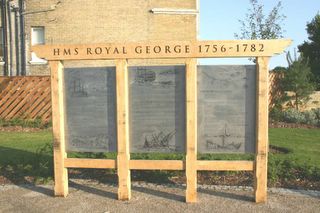
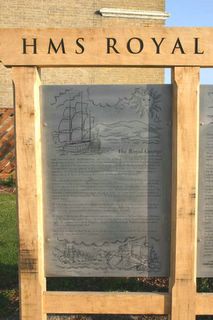
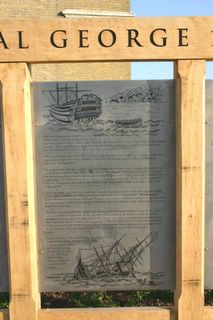
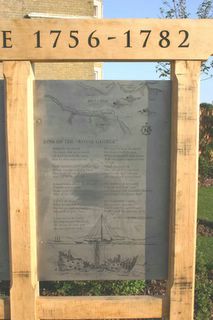
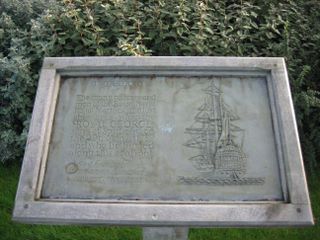
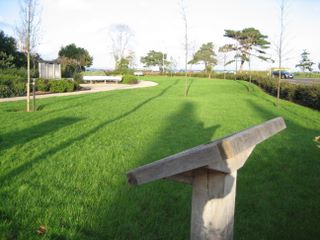
|
Inscription
The Royal George launched in 1756, was one of the finest ships that ever sailed. At 200 feet long, weighing 3745 tons, and carrying 100 cannon her quarter deck rose 32 feet above the waves and her three masts extended to 100 feet in height. At the outbreak of the Seven Years War against France and Austria she became the flagship of the Channel Fleet carrying Admiral Sir Edward Boscawen's flag on blockade duty with the Western Squadron. In 1759 the Royal George under the flag of Admiral Sir Edward Hawke, achieved distinction in the Battle of Quiberon Bay where the French fleet was defeated. Following further action she entered Portsmouth for maintenance, but by the time this work was completed the war was over. The planned return to the Western Squadron was not forthcoming. In 1763 she was laid up in Plymouth for 15 years manned by her standing officers and where dockyard workers were supposed to ensure good order. Renewed hostilities with France in 1778, including a failed French plan to capture the Isle of Wight, led to the Royal George returning to service with the Western Squadron. However she was found to be in poor condition and required further repair. In 1781 while on escort duty to a British convoy to Gibraltar she was able to regain her prowess when she took part in the capture of two Spanish convoys. Following this period of action, the Royal George again returned to Plymouth for another major overhaul. In August 1782 the Royal George sailed to join the fleet gathered at Spithead to relieve Gibraltar from the blockading Spanish forces. She was now the flagship of Rear Admiral Kempenfeldt and under the command of Captain Waghorn. On arrival at Portsmouth Waghorn ordered a minor repair to a submerged water cock. There was no time to allow for dry dock and the captain decided to heel the ship over by seven degrees to allow the job to be completed. The normal procedure would be to attach ropes to the masts pulling the ship over from another vessel. This would allow the safe release of the ship in an emergency by cutting the rope. However Waghorn elected to use an alternative method, moving all the cannon from one side beyond the centre line of the ship thus causing her to heel over. When work began there were 820 crew and a further 400 visitors made up of friends, family and tradespeople on board ship in addition to the 548 tons of stores and 83 tons of ammunition needed for the expedition. Work proceeded until the carpenter returned to the deck to report water entering the gunports and to request an order to "right ship". The Officer of the Watch, Lieutenant Hollingbery dismissed his appeal, and he was forced to seek out Captain Waghorn who gave to order to reposition the cannon some 20 minutes after she had begun to sink. It was too late. Water rapidly entered the ship and she capsized and sank in the middle of the Navy's main Solent anchorage on the 29th August 1782. Only 255 of the 1,220 on board survived. Among those who perished were the carpenter, many of the visiting women and children and Rear Admiral Richard Kempenfeldt. The subsequent Court Martial cleared Kempenfeldt and Waghorn and chose to blame the collapse of the ships hull through rot and neglect by the dockyard authority and Navy Board, a view supported by only two witnesses at the time. The Navy Board accepted the verdict and subsequently sabotaged attempts to salvage the vessel and so confirm her condition. It was not until 1832 following the abolition of the Board that attempts at salvage by divers John and Charles Deane who had invented the deep sea diving suit were successful and 29 cannon were recovered. These were subsequently melted down and used in the construction of Nelson's Column in Trafalgar Square which celebrates the triumph of the Royal George's sister ship HMS Victory. The hull however was found to be beyond repair. Bodies of many of the men, women and children were washed ashore at Ryde and are buried in the foreshore where you now stand and are commemorated by the 1964 Earl Mountbatten Memorial Plaque relocated in this garden. LOSS OF THE "ROYAL GEORGE"
Further Information
The casualties are reputed to have been buried on the site of what is now the canoe lake in Ryde, as well as the area to the eastern end of
the Strand where the gardens are situated.
|
||||||||||||||||||||||||||||||||||||||||||||||||